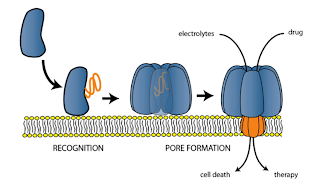Nanopore Therapeutics
Commonly, pore-forming proteins are expressed as soluble monomers. Each protomer contains a membrane-targeting element that often selectively engages a lipid or protein binding partner to recognize its target membrane. Subsequently they oligomerize on the surface of the bilayer and then insert into it to form a lesion.
Activation of lipid metabolism is an early event in carcinogenesis and a central hallmark of many cancers; and many tumors showed a different lipid composition as compared with normal tissues. We use a directed evolution approach to evolve the nanopore to engage selectively with target cancerogenic cells. The nanopore will then kill the cell or open a doorway for therapeutic drug delivery

References
Mutter N, Volarić J, Szymanski W, Feringa B, Maglia, G. Reversible photo-controlled nanopore assembly. JACS. (2019) doi.org/10.1021/jacs.9b06998
Mutter N, Soskine M, Huang G, Albuquerque IS, Bernardes GJL ,
and Maglia G. Modular pore-forming immunotoxins with caged cytotoxicity tailored by directed evolution. ACS Chem Biol. (2018) Oct 2. doi: 10.1021/acschembio.8b00720
Franceschini, L., Soskine, M, Biesemans, A, and Maglia, G. A nanopore machine promotes the vectorial transport of DNA across membranes. Nature Commun (2013). DOI:10.1038/ncomms3415
-In the news: DeRedactie, DeStandaard,
-Highlight in Scicasts, Science daily, Nanowerk, PhysOrg, UniverCellmarket
-In the news: DeRedactie, DeStandaard,
-Highlight in Scicasts, Science daily, Nanowerk, PhysOrg, UniverCellmarket
| Last modified: | 12 December 2019 2.31 p.m. |
